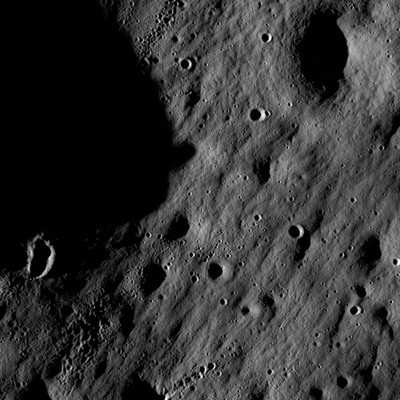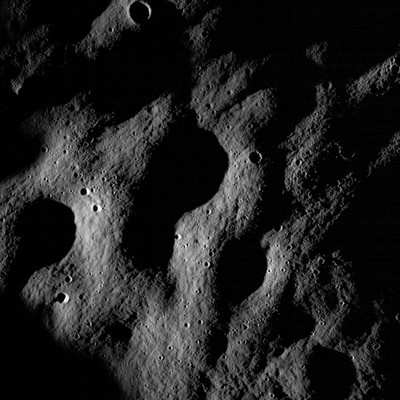Mission To Help Determine Safe Landing Sites For Return To The
Moon
NASA's Lunar Reconnaissance Orbiter, or LRO, has transmitted its
first images since reaching lunar orbit June 23. The spacecraft has
two cameras -- a low resolution Wide Angle Camera and a high
resolution Narrow Angle Camera. Collectively known as the Lunar
Reconnaissance Orbiter Camera, or LROC, they were activated June
30. The cameras are working well and have returned images of a
region a few kilometers east of Hell E crater in the lunar
highlands south of Mare Nubium.

As the moon rotates beneath LRO, LROC gradually will build up
photographic maps of the lunar surface. To view these first
calibration images, visit:
"Our first images were taken along the moon's terminator -- the
dividing line between day and night -- making us initially unsure
of how they would turn out," said LROC Principal Investigator Mark
Robinson of Arizona State University in Tempe. "Because of the deep
shadowing, subtle topography is exaggerated, suggesting a craggy
and inhospitable surface. In reality, the area is similar to the
region where the Apollo 16 astronauts safely explored in 1972.
While these are magnificent in their own right, the main message is
that LROC is nearly ready to begin its mission."
LRO will help NASA identify safe landing sites for future
explorers, locate potential resources, describe the moon's
radiation environment and demonstrate new technologies.
 The satellite also has started to
activate its six other instruments. The Lunar Exploration Neutron
Detector will look for regions with enriched hydrogen that
potentially could have water ice deposits. The Cosmic Ray Telescope
for the Effects of Radiation is designed to measure the moon's
radiation environment. Both were activated on June 19 and are
functioning normally.
The satellite also has started to
activate its six other instruments. The Lunar Exploration Neutron
Detector will look for regions with enriched hydrogen that
potentially could have water ice deposits. The Cosmic Ray Telescope
for the Effects of Radiation is designed to measure the moon's
radiation environment. Both were activated on June 19 and are
functioning normally.
Instruments expected to be activated during the next week
and calibrated are the Lunar Orbiter Laser Altimeter, designed to
build 3-D topographic maps of the moon's landscape; the Diviner
Lunar Radiometer Experiment, which will make temperature maps of
the lunar surface; and the Miniature Radio Frequency, or Mini-RF,
an experimental radar and radio transmitter that will search for
subsurface ice and create detailed images of permanently-shaded
craters.
The final instrument, the Lyman Alpha Mapping Project, will be
activated after the other instruments have completed their
calibrations, allowing more time for residual contaminants from the
manufacture and launch of LRO to escape into the vacuum of space.
This instrument is an ultraviolet-light imager that will use
starlight to search for surface ice. It will take pictures of the
permanently-shaded areas in deep craters at the lunar poles.
"Accomplishing these significant milestones moves us closer to
our goals of preparing for safe human return to the moon, mapping
the moon in unprecedented detail, and searching for resources,"
said LRO Project Scientist Richard Vondrak of NASA's Goddard Space
Flight Center in Greenbelt, MD.

While its instruments are being activated and tested, the
spacecraft is in a special elliptical commissioning orbit around
the moon. The orbit takes less fuel to maintain than the mission's
primary orbit. The commissioning orbit's closest point to the lunar
surface is about 19 miles over the moon's south pole, and its
farthest point is approximately 124 miles over the lunar north
pole.
After the spacecraft and instruments have completed their
initial calibrations, the spacecraft will be directed into its
primary mission orbit in August, a nearly-circular orbit about 31
miles above the lunar surface.
 ANN's Daily Aero-Term (04.14.24): Maximum Authorized Altitude
ANN's Daily Aero-Term (04.14.24): Maximum Authorized Altitude ANN's Daily Aero-Linx (04.14.24)
ANN's Daily Aero-Linx (04.14.24) Classic Aero-TV: 'We're Surviving'-- Kyle Franklin Describes Airshow Life 2013
Classic Aero-TV: 'We're Surviving'-- Kyle Franklin Describes Airshow Life 2013 Aero-News: Quote of the Day (04.14.24)
Aero-News: Quote of the Day (04.14.24) Airborne 04.09.24: SnF24!, Piper-DeltaHawk!, Fisher Update, Junkers
Airborne 04.09.24: SnF24!, Piper-DeltaHawk!, Fisher Update, Junkers





